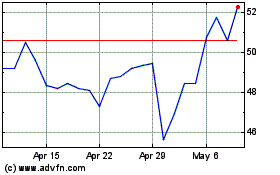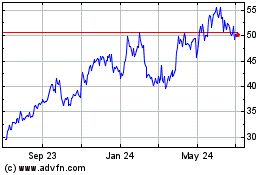Uranium Companies, Hit By Market Drop, Defend Nuclear Industry
March 14 2011 - 5:49PM
Dow Jones News
Uranium company executives defended the nuclear-power industry's
growth plans Monday after overheating at nuclear reactors in Japan
caused a rout in their share prices.
Most of the major uranium-miner stocks dropped more than 10%
Monday as investors feared Japan's reactor problems could endanger
the world-wide "nuclear renaissance"--a resurgence in uranium
commodities and stocks due to expectations of low future uranium
supply and increasing demand from new reactors.
Jerry Grandey, chief executive of Cameco Corp. (CCJ), the
world's largest publicly owned uranium company, said Monday that
the selloff in uranium shares was "largely driven by emotion." He
said that Cameco, which gets 18% to 20% of its revenue from Japan,
didn't expect any significant effect on its business now or in the
future.
Even if the 11 reactors that were in the earthquake and tsunami
zone were to defer part of their uranium purchases, Cameco would be
"well within" its guidance for the year, he said.
Of the world's 442 nuclear power plants, 54 are in Japan. The
Japanese government said Monday that the fuel rods in one of three
overheating reactors have fused together in a partial meltdown. A
partial meltdown occurs when uranium fuel begins to melt under high
temperatures, but still remains contained within the reactor. The
1979 Three Mile Island accident in the U.S. was a partial meltdown.
In a full meltdown, such as the 1986 Chernobyl disaster in the
Soviet Union, the rods melt completely and the release of energy
causes an explosion that contaminates the surrounding area with
radioactive material.
Despite Japan's problems, Grandey said Cameco's customers in
India, China, South Korea and other Asian nations, where the bulk
of the about 60 nuclear reactors are under construction or
refurbishment, have said they remain committed to their nuclear
program.
"Some voices have questioned whether the nuclear renaissance
will survive this disaster," Grandey said. "Looking beyond the
events of recent days, we at Cameco don't see a dramatic effect on
the fundamentals of our uranium business. Growth of nuclear
capacity in China, India, Korea and elsewhere ... has tremendous
momentum and we expect it will continue."
Amir Adnani, Chief Executive of Uranium Energy Corp. (UEC), said
Monday that it is too early for politicians or the media to begin
"writing the obituary of the nuclear renaissance." In retrospect,
the nuclear incidents in Japan may prove the ability of the nuclear
industry to respond to disasters, he said.
"The oil infrastructure went up in flames. The only
infrastructure left standing that was built in the 1970s were these
reactors. There wasn't a significant radiation release and so far
they've demonstrated that the safety systems for the most part have
worked."
Adnani and Cameco executives also said that despite the
incident, spot prices for uranium still reflected short supplies
and high demand.
Adnani said the rout in equity prices--his own company closed
down 19.2% on the American Stock Exchange Monday--was "completely
unjustified, due to the fact that you've got current demand from
440 operating nuclear reactors that will need uranium to generate
18% of the world's electricity," while supply hasn't kept up with
the growth in demand for decades.
The rout in equity prices will make it harder for
development-stage uranium companies to get financing, companies may
reconsider commissioning new projects and there may even be
softness in the spot uranium price, Adnani said.
"The capital markets, responding to this news over the weekend,
are putting a lot of pressure on a sector that was just starting to
get some life," he said.
-By Edward Welsch, Dow Jones Newswires; 403-229-9095;
edward.welsch@dowjones.com
Cameco (NYSE:CCJ)
Historical Stock Chart
From Mar 2024 to Apr 2024

Cameco (NYSE:CCJ)
Historical Stock Chart
From Apr 2023 to Apr 2024
